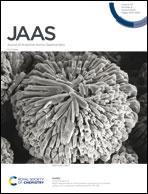Sensitivity enhancement of inorganic arsenic analysis by in situ microplasma preconcentration coupled with liquid chromatography atomic fluorescence spectrometry†
Abstract
In this work, an in situ dielectric barrier discharge trap (DBDT) was first utilized to preconcentrate inorganic arsenic (iAs) species coupled with liquid chromatography hydride generation atomic fluorescence spectrometry (LC-HG-AFS), and a novel LC-HG-in situ DBDT-AFS instrument was thereby fabricated. Considering the relatively deficient sensitivity of LC-HG-AFS and retention of As(V) in a strong anion exchange column, As(V) was chosen as a model species for iAs preconcentration. During the extraction of arsenic species in a rice sample using 1% (v/v) HNO3 and 1% (v/v) H2O2, As(III) was oxidized to As(V) being regarded as iAs. After LC separation, according to the retention time, only As(V) was trapped by 11 kV discharging under 110 mL min−1 air mixed with Ar; following sweeping by Ar gas for 190 s, iAs was released with 13 kV at 180 mL min−1 H2-rich Ar to the AFS for measurement. Via preconcentration, the limit of detection (LOD) of iAs reached 0.05 μg L−1 with ∼10 times enhancement in analytical sensitivity; the linearity (r) was > 0.997 ranging from 0.5 μg L−1 to 50 μg L−1 with 1.9% RSD (5 μg L−1, n = 6). The measured iAs in certified reference materials (CRMs) were all within their certified values, and the spike recoveries were in the range of 93–102%. With sensitivity, robustness, low power, small size and easy operation, the combination of LC and DBDT fulfilled the analysis of trace iAs in rice samples. In fact, other arsenic species can also be preconcentrated and detected to enhance the sensitivity by this proposed LC-HG-in situ DBDT technique via precisely synchronizing DBD trap and release with chromatographic retention. To focus on the food safety, iAs was chosen as a model arsenic species to verify the availability of in situ DBDT. Considering the versatility of DBD, in situ DBDT demonstrates a promising application for elemental speciation analysis and LC atomic spectrometry.



 Please wait while we load your content...
Please wait while we load your content...